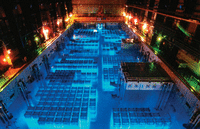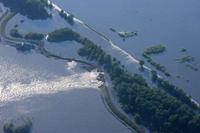-
Recycled glass in cement makes concrete stronger
Researchers have found that by mixing ground waste glass into the cement that is used to make concrete, the concrete is stronger, more durable, and more resistant to water; in addition, the use of glass helps reduce the amount of glass that ends up in landfills
-
-
Proposed EPA budget cuts funding from clean air and water grants
President Obama’s latest proposed budget for fiscal year 2013 cuts $105 million from the Environmental Protection Agency’s (EPA) budget, primarily from funds aimed at treating wastewater and drinking water
-
-
Faculty retention a major challenge for universities
New study shows men and women faculty retained at same rate; but median retention rate for all university professors is only eleven years; if a university hires 100 assistant professors tomorrow, in eleven years only fifty of them will still be at the school
-
-
Nuclear waste recycling for better nuclear power generation

Researchers aim to produce safe nuclear fuel that can be 80 percent recycled, compared to the current 1 percent; these fourth generation nuclear power systems can lead to a reduction of the amount of high-level, long-lived nuclear waste to a tenth of what it is today, while energy output can increase hundredfold
-
-
Invisibility cloak to protect buildings from earthquakes
Scientists show that by cloaking components of structures with pressurized rubber, powerful waves such as those produced by an earthquake would not “see” the building — they would simply pass around the structure and thus prevent serious damage or destruction
-
-
Advances in the use of photocatalysts to help keep water clean safe
Photocatalysis involves the acceleration of chemical reactions using the power of light; researchers experiment with different types of photocatalysts to reduce nitrates in water
-
-
Four-legged robot carries troops’ load
The increasing weight of military equipment has a negative impact on soldiers’ readiness and effectiveness; reducing the load on dismounted soldiers has thus become a major point of emphasis for defense research and development; the Legged Squad Support System (LS3) robot follows squad members through rugged terrain and interact with them in a natural way, similar to the way a trained animal and its handler interact, while carrying 400 lbs. of squad’s gear
-
-
Local officials oppose “unacceptable” levee ratings

In recent years as part of an effort to bolster the nation’s flood protection infrastructure, the Army Corps of Engineers has analyzed and declared more than 200 levee systems across the country as “unacceptable,” resulting in a firestorm of criticism from local officials
-
-
New technology will allow miniaturization of chemical sensors
A new measuring technology – based on measuring near-resonant nonlinear behaviors rather than measuring chemomechanically induced shifts in linear natural frequency – will allow a dramatic miniaturization of sensors; the miniaturization will make these sensors more suitable for first response, law enforcement, and military missions
-
-
Influx of ex-Soviet mathematicians changed mathematics in U.S.
One of the little-noticed effects of the collapse of the Soviet Union in 1992 was the way in which math is studied and taught in the United States; Soviet mathematicians who came to the United States reduced the role of American mathematicians in certain specialties, and in some specialties the likelihood of a competing American mathematician producing a top research paper has declined
-
-
New methodology evaluates risk of scarce metals
China produces more than 95 of the world’s rare Earth metals, making governments and businesses around the world uneasy; researchers develop a methodology ti answer two important questions: how do we know what is scarce? If we know a metal is scarce, how do we know whether we should worry about it?
-
-
Wireless underground robots for first responders
First responders may have to look for victims in hostile or challenging environments, such as clandestine tunnels, subway systems, and underground structures; sending a wireless robot to look around and pull victims out would be safer
-
-
Electron beam reduces virus-related health risk in lettuce, spinach
Current health-care costs in the United States associated with foodborne viruses are estimated at about $6 billion; scientists show that electron-beam irradiation can reduce the health risks in iceberg lettuce and spinach, but note that electron-beams are not meant to be used as a “stand-alone” or “clean-up” technology
-
-
Compressed natural gas as transportation fuel
A number of different fuel sources — ethanol, biodiesel, electricity, and hydrogen — have each shown their promise as an alternative to petroleum; scientists at Argonne Lab want to add one more contender to the list of possible energy sources for light-duty cars and trucks: compressed natural gas (CNG)
-
-
The strength of a spider web depends on design, not only on silk

New study shows that spider web’s durability depends not only on silk strength, but on how the overall web design compensates for damage and the response of individual strands to continuously varying stresses
-
More headlines
The long view
Autonomous Vehicle Technology Vulnerable to Road Object Spoofing and Vanishing Attacks
Researchers have demonstrated the potentially hazardous vulnerabilities associated with the technology called LiDAR, or Light Detection and Ranging, many autonomous vehicles use to navigate streets, roads and highways. The researchers have shown how to use lasers to fool LiDAR into “seeing” objects that are not present and missing those that are – deficiencies that can cause unwarranted and unsafe braking or collisions.
Tantalizing Method to Study Cyberdeterrence
Tantalus is unlike most war games because it is experimental instead of experiential — the immersive game differs by overlapping scientific rigor and quantitative assessment methods with the experimental sciences, and experimental war gaming provides insightful data for real-world cyberattacks.
Prototype Self-Service Screening System Unveiled
TSA and DHS S&T unveiled a prototype checkpoint technology, the self-service screening system, at Harry Reid International Airport (LAS) in Las Vegas, NV. The aim is to provide a near self-sufficient passenger screening process while enabling passengers to directly receive on-person alarm information and allow for the passenger self-resolution of those alarms.
Falling Space Debris: How High Is the Risk I'll Get Hit?
An International Space Station battery fell back to Earth and, luckily, splashed down harmlessly in the Atlantic. Should we have worried? Space debris reenters our atmosphere every week.
Testing Cutting-Edge Counter-Drone Technology
Drones have many positive applications, bad actors can use them for nefarious purposes. Two recent field demonstrations brought government, academia, and industry together to evaluate innovative counter-unmanned aircraft systems.
Strengthening the Grid’s ‘Backbone’ with Hydropower
Argonne-led studies investigate how hydropower could help add more clean energy to the grid, how it generates value as grids add more renewable energy, and how liner technology can improve hydropower efficiency.
